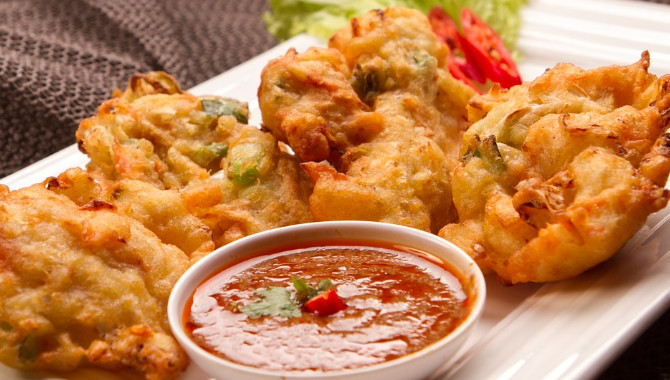With the modern prevalence of veganism, many restaurants now cater for vegans with a variety of menu items, and most vegans are adept at recognizing which foods they can and cannot eat. However, knowing what is off-limits can still present problems, even for experienced vegans, and this is especially true when eating foods from other parts of the world. Japanese cuisine, for example, is dominated by seafood and vegetables, but it can be difficult to know which vegetable meals might contain animal products, with tempura being one example of a dish that causes some confusion.
So is tempura vegan? Assuming it is a vegetable tempura dish, made in the traditional way, the answer is likely to be ‘yes’. However, there are exceptions to this, even with traditional Japanese cooking, and these non-vegan varieties are more common with western interpretations of tempura cooking.
It is certainly perfectly possible for vegans to eat vegetable tempura and to make it at home, without needing to make adjustments to traditional recipes. With that being said, tempura batter is sometimes made using animal products, so you should not automatically assume that all tempura is vegan-friendly. In this article, I will cover what tempura is, how tempura batter is made and what the main pitfalls are for vegans. I will also go into some of the ways you can avoid non-vegan tempura and explain how to make a vegan-friendly tempura batter at home.
What is Tempura and is it Vegan?
Tempura is a Japanese dish, where various food types are battered and deep-fried, with the most popular options being seafood or vegetables. While the seafood option is non-vegan for obvious reasons, vegetable tempura is usually vegan-friendly – at least when the tempura is cooked in the traditional way, using the core ingredients. Examples of vegetables that are regularly eaten with tempura batter include mushrooms, broccoli, peppers, onions and potatoes.
The primary difference between tempura batter and other forms of batter is that tempura is extremely light, both in terms of its color and its texture. This is generally achieved through a combination of a relatively small list of ingredients and the use of a low-gluten flour variety. At its most basic, tempura batter can be made from a simple combination of either iced or sparkling water and soft or weak wheat flour. Given this core ingredients list, you should see that there is no logical reason why a vegan would need to avoid vegetable tempura dishes entirely.
Even when recipes become slightly more complicated, many vegetable tempura dishes will still be suitable for vegans. For example, spices may be added to the batter mix, in order to enhance the flavor, while sodium bicarbonate (baking soda) is sometimes used as a leavening agent, in order to optimize the texture. Some restaurants will use a special tempura flour and this flour can also be purchased from supermarkets. It will generally be vegan-friendly and consist of simple low-gluten flour and a leavening agent. So, as you can see, most tempura recipes will be vegan-friendly.
Indeed, when buying vegetable tempura from a traditional-style Japanese restaurant, the only real problem you may encounter is a tendency for some restaurants to use whole eggs or egg yolk in their batter mix. For this reason, you should always ask whether eggs are used in the mix before you order. In some cases, it may be possible to request that your tempura batter is made without the use of eggs, but not all restaurants will alter their recipe.
The likelihood of encountering non-vegan tempura increases when you are ordering from western restaurants, even if they specialize in tempura style cooking, and it can be especially likely in restaurants where tempura is simply one option on a large and varied menu. The use of eggs is common in western countries, for instance, and some restaurants may even make use of other animal products, such as butter or milk, although this is much rarer.
It is also worth noting that some tempura dishes will be served with a sauce. While the sauce will usually be suitable for vegans, you will still need to double-check this. The good news is, it will almost always be a dipping sauce, meaning there is no need to worry about cross-contamination. However, depending on your reasoning on why to become vegan in the first place, you may wish to avoid paying money for a non-vegan sauce, so it is best to ask anyway.
So what are the best ways to go about avoiding non-vegan tempura varieties?
How to Avoid Non-Vegan Tempura
When making your own tempura, avoiding non-vegan recipes is fairly straight forward. There are plenty of recipes that do not require the use of any animal products, as I will cover in the next section. Even if you find a recipe that does call for the use of eggs, you could still follow it by substituting the egg with a vegan egg replacement product.
If you are ordering tempura from a traditional Japanese-style restaurant that specializes in this style of cooking, there is a good chance that your food will be vegan. However, it is still important to ask, as even some authentic restaurants will add egg yolk or whole egg to their mixture. Asking becomes even more important in western-style restaurants, where tempura is an option on the menu, but where the restaurant does not specialize in this type of cooking.
I personally recommend that you tell somebody at the restaurant that you are vegan, regardless of the nature of the restaurant you are in. This will allow kitchen staff to make adjustments to avoid accidental cross-contamination and also allow your server to point out anything you order which might be problematic when living the vegan lifestyle.
One potential grey area you may need to consider is whether or not you are willing to have your vegetable tempura fried in the same vat that seafood or meat tempura is cooked. This will depend on your own personal preferences, how strict you are with your vegan diet and the things that influenced your decision on why to become vegan in the first place. If you are not happy with this, you will likely need to contact them in advance, or you risk having to leave the restaurant if they are unable to make this adjustment to the way they cook vegetable tempura.
Making Vegan Tempura At Home
Traditional Japanese-style tempura is reasonably simple to make at home and a fairly small number of ingredients are required. In fact, in order to make vegan-friendly vegetable tempura, you will only need the following:
- 350g flour (soft wheat flour is best)
- 300ml sparkling water (chilled)
- Vegetables (mushrooms, broccoli, peppers, onions, etc.)
- A pinch of table salt
- Sunflower oil, or a flavorless equivalent
Prepare your vegetables, so they are ready to fry. Ideally, you want your pieces of vegetable to be cut into pieces that are roughly the same size. Then, heat your oil in a large pot until it reaches a temperature of around 180°C / 350°F. If you are planning on cooking potatoes, or other vegetables that may take a while to cook, it is a good idea to lower the temperature to around 330°F, so that you do not accidentally over-cook the batter.
While the oil is heating, use a bowl to combine the flour, the sparkling water and a pinch of salt. This will serve as the batter mix. Some recipes recommend adding ice, I find that it is best to leave this out, as it can alter the levels of liquid in the mix. Stir the batter mix until most of the lumps are gone. However, a small number of lumps remaining is actually preferable, as this will mean the mix retains more air, giving it a lighter quality.
Add the vegetables to the batter mix and coat them evenly. Then, using a slotted spoon, add the vegetables to the oil and deep fry for a few minutes. You should turn the vegetables at least once during the cooking. Remove the battered vegetables once the batter has turned a pale golden color, and drain any excess oil from the batter before eating.
Are Pre-Made Tempura Mixes Vegan?
When making tempura at home, some people opt to buy pre-made tempura batter mixes and these are found in Asian food stores and even some supermarkets. While they will make the whole process significantly easier – often requiring the simple addition of water – you will need to take care, as some of these products are not vegan-friendly. Be sure to check the ingredients list for any reference to animal products. The main problematic ingredients you might encounter are egg powder or milk powder, but you should check for use of butter as well.
In a small number of cases, food additives can cause problems. These are usually added to the mix in order to help preserve the food for longer, to improve its texture, or to assist with the color of the batter. You will need to be especially careful with certain raising agents, thickeners and E numbers. Read the allergy information closely too, as you may find that a product contains traces of an animal product, even if the animal product is not a core ingredient.
Where possible, try to stick to brands that specifically market their products as being vegan-friendly or products that have been certified as vegan by a credible organization, such as The Vegan Society.
If you are still unsure about whether a certain product is suitable for vegans or not, it may be a good idea to contact the brand directly. Some products feature a customer support phone number on the packaging and if you give this number a call, most brands will be more than happy to confirm whether or not their product is suitable. Failing this, you might be able to contact them via email, through a contact form on their website, or via social media platforms.
Welcome to VeganClue - My name is Robert Van De Ville and together with my team we spent hundreds of hours researching the most relevant topics for Vegans and non yet Vegans. Are you looking for more information about Veganism, animal welfare, diet, health, and environmental benefits of the Vegan lifestyle? You are in the right place! Enjoy the site.

